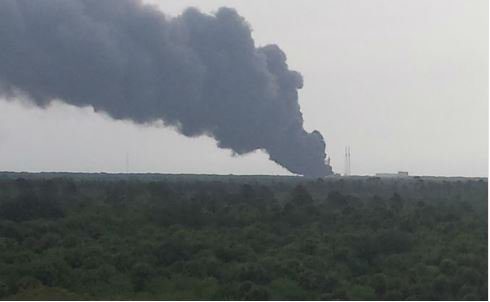Jason Davis • Sep 01, 2016
SpaceX's Falcon 9 rocket explosion: What we know and don't know
This morning, a SpaceX Falcon 9 rocket exploded on the launch pad at Cape Canaveral Air Force Station Space Launch Complex 40. This is currently the only active East coast pad SpaceX uses to launch its Falcon 9 rockets. It's located on Cape Canaveral, but not part of NASA's Kennedy Space Center, and SpaceX leases the pad from the U.S. Air Force.
There were multiple reports of an explosion just after 9:00 a.m. EDT. SpaceX issued a statement on Twitter confirming the accident at 10:42 a.m., and has since posted this followup:
"At approximately 9:07 am ET, during a standard pre-launch static fire test for the AMOS-6 mission, there was an anomoly at SpaceX's Cape Canaveral Space launch Complex 40 resulting in loss of the vehicle.
The anomaly originated around the upper stage oxygen tank and occurred during propellant loading of the vehicle. Per standard operating procedure, all personnel were clear of the pad and there were no injuries.
We are continuing to review the data to identify the root cause. Additional updates will be posted as they become available."
The U.S. Air Force 45th Space Wing, which oversees launch activities for America's Eastern rocket range, had this to say:
"At approximately 9:07 a.m. this morning an explosion occurred at launch complex 40 on Cape Canaveral Air Force Station. Initial reports indicated that there were no casualties and has been no threat to public safety. CCAFS Emergency Management is providing the initial on-scene response. Roadblocks will be set up in and around CCAFS, so we ask that you avoid the entrance to the Air Force Station until further notice. We will provide updates as they become available."
A dramatic video of the accident was captured by U.S. Launch Report and posted to YouTube:
The payload
The payload was Amos-6, a communications satellite bound for geostationary orbit high above the Earth, where satellites match their orbital period with Earth's rotational rate to remain fixed above a specific point on the ground.
Amos-6 was owned by the Israeli company Spacecom, and slated to be positioned over Africa. One of the satellite's users was Facebook, which is attempting to bring broadband services to remote regions of Sub-Saharan Africa.
The accident
The launch window for the Falcon 9 was scheduled to open at 3 a.m. EDT on Saturday, Sept. 3. SpaceX regularly conducts a "static fire" test a couple days before launch, during which the rocket remains held to the pad while the engines fire up for a few seconds. Today's accident originated near the rocket's upper stage oxygen tank, which was being pressurized in preparation for the firing. It remains unclear whether the accident was caused by the rocket, the launch pad infrastructure or a combination of both.
This is not the first time SpaceX has conducted a static fire with the payload already integrated at the top of the rocket. Previous static fires with the company's International Space Station-bound Dragon capsule have been done with Dragon already aboard.
Effects
When rockets explode on or near their launch pad, significant damage can be caused to ground infrastructure. SpaceX will have to troubleshoot what happened and convince its customers—which include NASA—that it has fixed the problem. It will also have to repair any damaged ground equipment.
NASA says this will not affect the launch of NASA's OSIRIS-REx on Sept. 8. SpaceX's pad is located just a mile and a half from Space Launch Complex 41, where the United Launch Alliance Atlas V rocket holding OSIRIS-REx is housed. However, the Atlas V would have been protected within the complex's Vertical Integration Facillity at the time of the explosion.
Support our core enterprises
Your support powers our mission to explore worlds, find life, and defend Earth. You make all the difference when you make a gift. Give today!
Donate

 Explore Worlds
Explore Worlds Find Life
Find Life Defend Earth
Defend Earth


